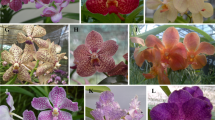Abstract
Traditional propagation of lemon balm (Melissa officinalis L.) is inefficient for establishing a good quality clonal population. Results of the presented experiments outline an effective method for micropropagation of this species. Following culture initiation from shoots of field-grown plants on growth regulator free Murashige–Skoog medium, rapid shoot multiplication with only rudimentary root formation could be achieved on media containing various concentrations of indole-3-acetic acid and 6-benzyladenine. The combination of 5.71 μM indole-3-acetic acid and 6.66 μM 6-benzyladenine resulted in the best multiplication. Transfer of propagules to media containing indole-3-acetic acid and kinetin did not result in shoot proliferation; however, single plantlets grown on media containing 5.71 μM indole-3-acetic acid and 13.9 μM kinetin developed more compact shoots and stronger roots than the control plants and were suitable for acclimatisation with an efficiency over 95%.
Similar content being viewed by others
References
Dimitrova Z, Dimov B, Manolova N, Pancheva S, Ilieva D & Shishkov S (1993) Antiherpes effect of Melissa officinalis L. extracts. Acta Microbiol. Bulg. 29: 65–72
Gbolade AA & Lockwood G (1989) The constituents of Melissa officinalis cell cultures. Planta Med. 55:228
Gbolade AA & Lockwood G (1992) Metabolic studies of volatile constituents in tissue cultures of Melissa officinalis. J. Plant Physiol. 140: 28–32
Herrmann EC & Kucera LS (1967) Antiviral substances in plant of the Mint family (Labiatae). II. Nontannin polyphenol of Melissa officinalis. Proc. Soc. Exp. Biol. (NY) 124: 869–874
Murashige T & Skoog F (1962) A revised medium for rapid growth and bio-assays with tobacco tissue cultures. Physiol. Plant. 15: 437–497
Rech EL & Pires MJP (1986) Tissue culture propagation of Mentha ssp. by the use of axillary buds. Plant Cell Rep. 5: 17–18
Schultze W, Hose S, Abou-Mandour A & Czygan FC (1993) Melissa officinalis L. (Lemon balm): in vitro culture and the production and analysis of volatile compounds. In: Bajaj YPS (ed) Biotechnology in Agriculture and Forestry, Vol. 24 (pp 242–268) Springer-Verlag, Berlin, Heidelberg
Tavares AC, Pimenta MC & Goncalves MT (1996) Micropropagation of Melissa officinalis L. through proliferation of axillary shoots. Plant Cell Rep. 15: 441–444
Yepes, LM & Aldwinckle HS (1994) Micropropagation of thirteen Malus cultivars and rootstocks, and effect of antibiotics on proliferation. Plant Growth Regul. 15: 55–67
Author information
Authors and Affiliations
Rights and permissions
About this article
Cite this article
Mészáros, A., Bellon, A., Pintér, É. et al. Micropropagation of lemon balm. Plant Cell, Tissue and Organ Culture 57, 149–152 (1999). https://doi.org/10.1023/A:1006359825024
Issue Date:
DOI: https://doi.org/10.1023/A:1006359825024




